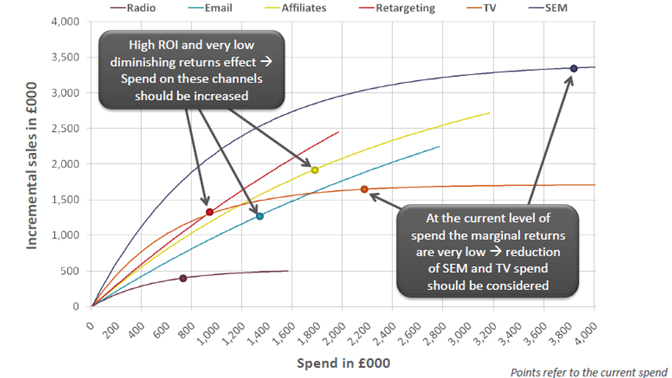Two of the biggest challenges marketers face are forecasting sales and proving ROI of marketing activities. As data driven marketing continues to gain popularity, marketers are looking to marketing mix modelling to overcome these pain points and optimise marketing spend.
Put simply, marketing mix modelling uses historical data to show the sales impact of marketing activities. As a marketer or media planner it allows you to review the effectiveness of past campaigns and forecast sales based on investment in marketing activities; assisting you to spend marketing budget wisely and decide on the optimum price point.
The model uses econometrics, the application of mathematical, statistical and computer science methods to data, to work out sales (dependent variable) by using marketing activity data (independent variables). The econometric model sorts through the data to seek out relationships between sales and other factors (marketing spend, price, promotions, weather, competitors activities, economics).
Once this model has been established it reveals how a change in each marketing variable impacts sales. For instance it could show the sales impact of every £1000 spent on television ads, as well as how a £1 price increase will impact sales. These equations are then able to work in unison to forecast sales based on any number of marketing activity inputs.
Typical data inputs are those readily available to an organisation including sales data, pricing, GRPs, media spend, impressions and click through rates. Once all of the desired variables are inserted and the number crunching is done, you can derive the sales impact of each marketing activity, price elasticity, effectiveness of price promotions, point of diminishing returns for marketing spend and ROI of each activity.
Figure 1 shows the model identifying the point of diminishing returns, indicating the level at which sales are no longer increasing proportionally with marketing spend. For example you can see that as SEM spend increases past £2,000, there is no longer a substantial impact on sales, whereas further investment in email marketing will continue to provide a significant sales impact. This indicates where marketing budget should be taken from and reallocated to.
To apply this model even further, historical data is used to forecast sales based on any combination of marketing activities. For example, inputting proposed media spend for each platform, price promotions and email marketing spends can derive the expected number of sales. This model becomes increasingly powerful over time, as more historical data is captured and you are able track trends and see which activities are becoming more or less effective over time.
Marketing mix modelling is a much more comprehensive way of analysing marketing spend than previously popular methods, still being used by some marketers today. For smaller businesses, sales forecasting and marketing control is often still based on subjective estimations by the marketing department, others use consumer research based on intentions to purchase, rather than taking advantage of available data to increase accuracy.
MMM is a huge step forward from these techniques, which do not offer much guidance on optimising marketing spend, and being a non-data driven approach, deliver questionable forecasts. Other mathematical models are available to marketers of course, but these mostly graph sales against one factor (e.g. price or TV spend). The benefit of MMM is in its ability to show pure impact on sales of each of marketing activity as well as the optimal combination of all activities.
There have been some concerns that the MMM approach encourages marketers to favour price promotions over advertising, which much research has indicated yields high short term sales growth, but is detrimental to a brand in the longer term. This is something that some brands do need to consider, depending on their objectives. If your marketing mix model indicates you should do unrealistic price promotions and cut back on advertising, you might think twice. Marketing mix modelling, or any sort of evaluation/forecasting method, should always be looked at in the context of greater marketing and business objectives.
Of course, marketing mix modelling is not the answer to all marketing problems; at the end of the day markets are volatile, you can’t predict competitor activity and consumers can behave in mysterious ways, making accurate forecasting a near impossible feat. However, MMM is a good place to start for a data driven approach to marketing spend evaluation and planning, as well as sales forecasting.
To make the best marketing decisions for your business, the optimal solution is pulling together all of the marketing intelligence, data and models available, as well as applying a bit of common sense.






